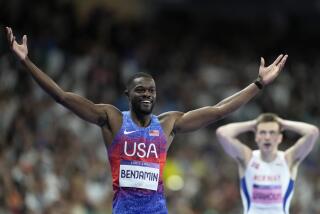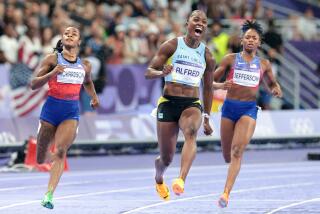IN THE LONG RUN
- Share via
Statistically, Deena Drossin should be running in the women’s 5,000 meters instead of the 10,000 in the Olympic Games in Sydney.
Whether looking at the all-time U.S. or 2000 world list, Drossin ranks substantially higher in the 5,000.
So why has the 1991 graduate of Agoura High chosen to run in the Olympic 10,000?
Because she won the 10,000 at the Olympic trials at Cal State Sacramento in July and it’s the race she feels she has the greatest room for improvement.
“I was ecstatic to win my first national championship on the track [in the 10,000],” Drossin said of the U.S. trials. “And I’ve never been in any international 10K where I felt like I could run really fast. I basically want to use some of the best runners in the world to drag me through to a really fast time.”
Drossin, 27, ran a career best of 31:51.05 to win the 10,000 on the first day of the U.S. trials and move to ninth on the all-time U.S. performer list. But subsequent times of 14:51.62 in the 5,000, the second fastest in U.S. history, 8:42.59 in the 3,000 and 4:07.82 in the 1,500 indicate she can run substantially faster in the 25-lap event.
“I was actually wanting to run faster in all of my races,” Drossin said of the 1,500, 3,000 and 5,000 bests she ran in Europe. “Although I was running [career bests], my expectations were higher. But I really had a heavy [training] load [at the time], so after I stepped back and thought about that, I was pretty happy.”
Drossin, second behind Regina Jacobs in the 5,000 at the trials, will run in a qualifying heat of the 10,000 on Sept. 27. She is picked to finish 10th in the final by Track & Field News, although her best is nearly 1:30 slower than that of 1999 world champion Gete Wami of Ethiopia.
Don’t expect her to be intimidated by the competition, however.
Drossin has gained a reputation for going out with the leaders in the big invitationals in Europe. The resident of Alamosa, Colo., won’t change that tactic now.
“I’m going to basically try to hang on for as long as I can and a good time will come,” she said. “I was on pace to run 14:45 with three laps left in [the 5,000 in which she ran 14:51.62], but the pace slowed to a 73 and 74 on the next two laps. . . . Looking back, I should have taken the lead and pushed it, but [the slowing pace] surprised me and I hesitated.”
Hesitant is an adjective seldom used to describe Drossin, winner of the last three U.S. cross-country titles at 8,000 meters.
She was a well known age-group competitor for the Las Virgenes Comets track club as a kid and won three state titles in cross-country and two in track during her high school career at Agoura.
She ran superbly during her first 1 1/2 years at Arkansas, placing second in the 1992 NCAA cross-country championships and in the 5,000 in the 1993 indoor track championships. But injuries caused her to lose her enthusiasm for running after her sophomore year.
With her desire waning during her final three years in Fayetteville, she decided that a change in scenery was necessary after graduating with degrees in English and journalism in 1996.
“I knew if I was ever going to run well again, I needed to get into a new environment,” Drossin said.
Enter Myron Donley, a former assistant at Arkansas who put Drossin in touch with distance guru Joe Vigil.
Vigil guided the Adams State (Colo.) College men’s and women’s cross-country and track programs to 25 NAIA or NCAA Division II titles from 1965-93 and continued coaching post-college runners after retiring.
“Joe was the first coach I talked to,” Drossin said. “But after talking to him, I just felt like he was the one to get me going and keep me motivated. He was so passionate about running.”
Drossin has slashed 61 seconds off her best in the 5,000 and 2:20 off her best in the 10,000 since being coached by the 70-year old Vigil, who figures the marathon might ultimately be Drossin’s best race.
That’s why he applauded her decision to run the 10,000 instead of the 5,000 in Sydney.
“From my vantage point as a coach, she is a longer-distance runner than a shorter-distance runner,” Vigil said. “But the 5,000 is her favorite event so she was leaning toward that race going into the trials.”
Drossin began to change her mind after pulling away over the final 3 1/2 laps of the 10,000 in Sacramento. The decision was all but finalized when Jacobs sped past Drossin with 3 1/2 laps left in the 5,000.
Vigil doesn’t foresee Drossin winning a medal in the 10,000 in Sydney, but he’d like to see her challenge the U.S. record of 31:19.89 set by Lynn Jennings in finishing third at the 1992 Games in Barcelona.
“If the [weather conditions] are right and she gets in the thick of things in the final, she can run between 31:20 and 31:30,” Vigil said. “Our goal will be to try and run as close to five-minute miles as she can for the first six miles and then hold that pace to the finish.”
Regardless of what happens, Drossin already has gained satisfaction in making her first Olympic team.
“The Olympics were just a dream growing up in youth track and in high school,” she said. “They were so far foreign to the sport I was in. But when I moved to Colorado, it became a goal of mine. . . . To have the dream become a reality has just been fabulous.”
(BEGIN TEXT OF INFOBOX / INFOGRAPHIC)
PROFILE
DEENA DROSSIN
Age: 27
Birthplace: Waltham, Mass.
Residence: Alamosa, Colo.
High school: Agoura
College: Arkansas
Honors: Set a meet record of 31:51.05 in winning the 10,000 meters in the Olympic track and field trials. . . . Ranks second on the all-time U.S. list in the 5,000 at 14:51.62. . . . Finished 11th in the 10,000 in the 1999 world championships. . . . Has won four national cross-country titles. . . . Won a combined total of five state titles in cross-country and track at Agoura.
SYDNEY SCHEDULE
What: Women’s 10,000 meters
When: Sept. 27 and Sept. 30
Where: Sydney Olympic Stadium
Qualifying: First round, Sept. 27; final, Sept. 30.
Medal favorites: Gete Wami, Ethiopia; Paula Radcliffe, Great Britain; Derartu Tulu, Ethiopia; Fernanda Ribeiro, Portugal; Berhane Adere, Ethiopia.
More to Read
Go beyond the scoreboard
Get the latest on L.A.'s teams in the daily Sports Report newsletter.
You may occasionally receive promotional content from the Los Angeles Times.






